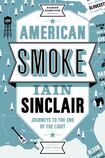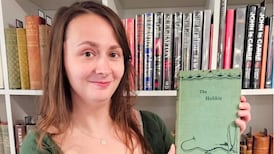
In the summer of 1967 Iain Sinclair made a television documentary about the proto-hippy beat poet Allen Ginsburg. It was called Ah, Sunflower after the poem by William Blake and was, according to Sinclair today, absolute junk. Nevertheless it paid him a handsome £4,500, with which he bought himself a Georgian house in the London borough of Hackney, where he has lived these past 40 years. During that time Sinclair has written a series of extraordinary books and novels about London – White Chappell, Scarlet Tracings, Downriver, Lights Out for the Territory – which mix elements of social surrealism with pavement-pounding satire.
For all his London credentials, Sinclair has more often looked to the US. Bored by the English curriculum at his public school in Cheltenham in the late 1950s, the aspirant author was thrilled to discover the work of Jack Kerouac. No writer could have been further removed from the kitchen-sink dramas and class antagonisms of England at that time. The Beat novelists and poets of the United States in the 1950s wore roll-neck sweaters and let out a breathy “yeah” for bebop and Jackson Pollock.
By the time Sinclair came to Ireland in 1962, to study English literature, the beats were a staple of underground British culture. At Trinity College Dublin, Sinclair tried to float a magazine of beat and other off-piste writings. Only one author deigned to contribute: William Burroughs, whose most famous novel, Naked Lunch, contained passages of Swift-like scatology. Burroughs's contribution was a typographical eccentricity that jettisoned conventional narrative for a collage-like impasto of random impressions; the Dublin printers failed to get a single edition of the magazine out.
For Burroughs, who knew Kerouac intimately, the term “beat” derived not from “beatific” but from the more prosaic “wiped out”. Hipster writers were beat from being on the road too long. Kerouac, an alcoholic malcontent, was often downbeat to behold. Like Ginsburg, he was a jazz-enthused, pot-smoking drifter figure who wrote of American life in the underbelly. Sinclair’s own writing, with its meandering, associative flow of ideas and impressions, owes much to Kerouac.
Literary heroes
In
American Smoke
, a hybrid of memoir and travelogue, Sinclair undertakes a series of literary pilgrimages across North America to “reconnect” with beat and other literary heroes of his youth. Among them is the English novelist Malcolm Lowry, who drank himself into an early grave, Kerouac-style, with the help of cooking sherry, meths and even bottles of skin bracer. Lowry’s 1947 Mexican masterpiece,
Under the Volcano
, was hugely admired by the beats; the novel’s mescal-inspired grotesqueries – grinning chocolate skulls, twitching centipedes – might have issued from the charnel house of Burroughs’s imagination.
By his own admission Sinclair is congenitally incapable of not seeing coincidences. American Smoke is thus a study in coincidence. After surveying the gin-blighted life of Lowry in British Columbia, Sinclair digresses at length on the subject of Lowry's Italian publisher Giangiacomo Feltrinelli. A celebrity gauchiste with likely terrorist connections, Feltrinelli blew himself up in 1972 apparently trying to sabotage a Milanese electricity pylon. Sinclair moves on (somewhat confusingly) to the Sicilian island of Vulcano, where Lowry spent a blissful Mediterranean idyll with his actor wife, Marjorie Bonner, before going home to die in England in 1957. In turn, Sinclair goes on, Vulcano was the setting for an Italian film, Volcano, starring the smouldering Anna Magnani, who later appeared in movies by Pasolini and Fellini. And so on and so forth.
Sinclair’s unstoppable flow of literary and film history facts is not without flaw. (Pasolini was published not by Feltrinelli, as Sinclair says, but by Einaudi and, subsequently, Garzanti.) However, the book’s mosaic of punchy prose and transposed quotations from other writers (among them Samuel Beckett and the tragically inebriated Charles Jackson) keeps the pages turning. Especially good are the chapters on Kerouac’s “fellow Massachusetts” author Charles Olson, whose Ezra Pound-influenced beat poetry impressed Sinclair from an early age.
While in Kansas, Sinclair calls on the saturnine former heroin junkie Burroughs. Burroughs’s attraction to what remained outside his Waspish class and culture (whether it was homosexual blue films in 1970s London or marijuana in postwar Tangier) fascinates Sinclair. In Mexico City in 1951, he reminds us, Burroughs accidentally shot dead his wife Joan Vollmer by attempting to blast a wine glass, William Tell style, off her head. Haunted by the killing, Burroughs was prey all his life to disabling bouts of melancholy.
In the late 1950s he began to experiment with the “cut-up” method of writing advocated by his homosexual avant-garde painter friend Brion Gysin. Sinclair’s own prose never descends to a Burroughsian mishmash but remains very readable and often poetic. (“Rain was still coming down, more mood music than nuisance.”)
Along the way Sinclair hails the New York hustler and part-time author Herbert Huncke, virtually an icon for the beats. Huncke's journals and the short stories he collected in The Evening Sun Turned Crimson chronicled the haunted, lonely people of 1920s Chicago speakeasies and New Orleans brothels.
American Smoke, a terrific read, is tinged with the autumnal sense of a 70-year-old author looking back on his younger, more idealistic self, and quite liking what he sees.










